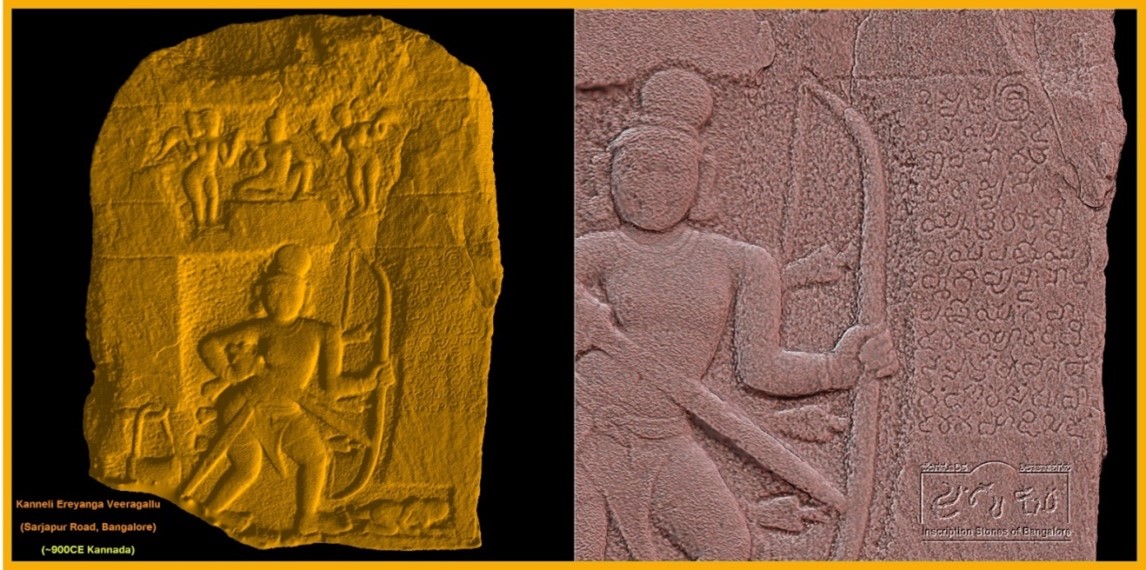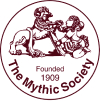- Wishlist 0
- |
- Cart 0
- |
- Account

The project aims to 3D digitally conserve 1500 ancient stone inscriptions in Bengaluru and Ramanagara districts.

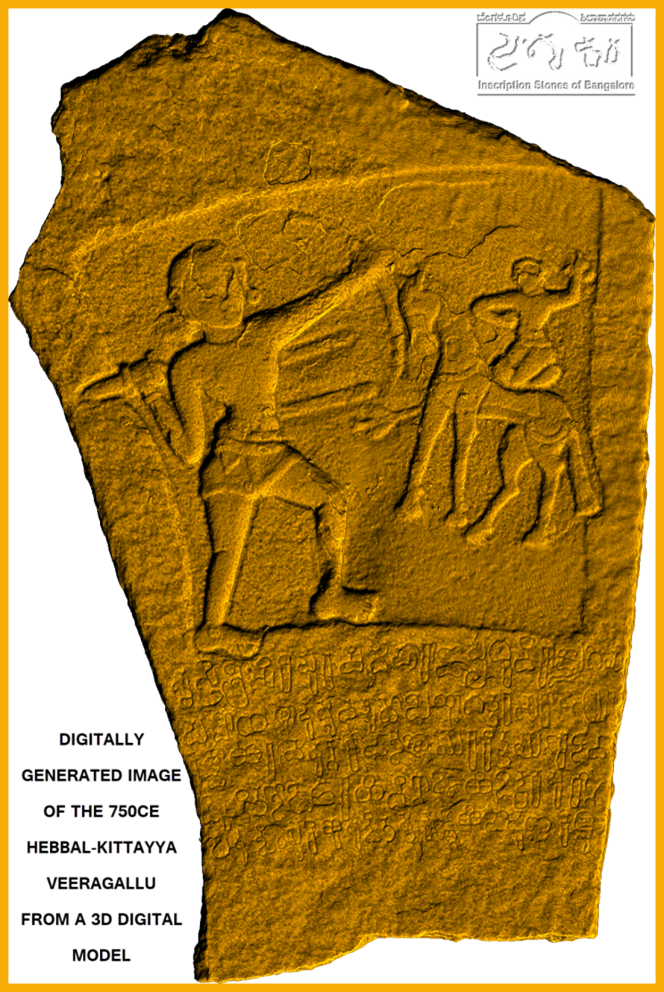
Bengaluru / Bangalore’s past can be traced to prehistoric times; very few modern urban metropolises in the world can claim to such incredible heritage. The city during various times has been governed by Ganga, Chola, Hoysala, Vijayanagara, Bijapur Sultanate, Maratha, Hyder Ali, Tipu Sultan, Wodeyar and British rulers. Every ruler has left some mark on the city.
Bengaluru is often mistakenly thought to be a “new” city without much history. It is perceived more as a modern, thriving-bustling global city. However, within Bengaluru city we have about 175 stone inscriptions from 750 CE to 1700 CE discovered and documented in books and journals such as the Epigraphia Carnatica, Itihasa Darshana, Itihasa Darpana, QJMS.
Epigraphs (stone inscriptions are a type of epigraph) spanning thousands of years are our primary source for accurate information about the past. Such stone inscriptions have been intensely combed for, studied, deciphered, and documented in the past one hundred years or so by researchers, archaeologists and others. An inscription discoverer-decipherer (called an Epigraphist) traditionally documents the inscription with a paper imprint (called an estampage) and a descriptive article in a history book-journal. However, once a stone inscription is documented, the stone itself is often ignored and soon forgotten as subsequent studies by researchers and historians tend to be mostly book based. In the state of Karnataka, it is estimated that about 30,000 stone inscriptions have been discovered and documented and some 10,000-20,000 stone inscriptions are still to be discovered and documented.
Fig 2, a map shows the precise distribution of Bengaluru’s inscriptions against the backdrop of BBMP wards. Wards are coloured based on the mention of a place name within the ward on an inscription stone of some century (legend given in the bottom of the image). However, a thorough ground search for these 175 hoary Bengaluru’s inscriptions tells us that only some 60-70 inscriptions are traceable today. These surviving inscriptions are indicated in
fig 1 with a green coloured heart icon. Many inscriptions are victims to crass urbanisation and destroyed (fig 3)1 due to apathy and ignorance, mostly in the past 2-3 decades. These are indicated in fig 2 with a red skull icon. Each of these inscriptions was an original record of a significant event in the past at the installation site of the inscription. From studying these inscriptions, we learn Bengaluru and its localities have an incredible 1500 years of documented past! There seems to be no comparable global city in the world blessed with such written records of its past, yet only a handful of Bengalureans know about these and an even smaller number of people have seen these stone inscriptions!
Traditionally inscriptions have been studied and information abstracted at a very high level in the form of political history narrations. However, all inscriptions also contain an extraordinary amount of local information related to the place of inscription. This is how we know, when a lake was built, about the people who lived in the place, their heroes, their religions, their languages, their problems…
Figs 4 & 5 are word-clouds that show the antiquity of Bengaluru’s localities and lakes as gleaned from inscription stones (PVK article). In these word clouds, larger the font size, older the locality/lake. The year of first mention of the place-lake name in an inscription is also given in brackets.
Ironically, many of these historic inscription stones have been destroyed and are not available for residents of those localities to see, cherish and celebrate! The only places where we learn about these lost inscriptions are in esoteric books such as the Epigraphia Carnatica.
With increased levels of education and prosperity in society and easy access to information, there is an increase in awareness and interest in history and heritage in people. As a result, there is a significant un-met, insatiable thirst in common people to learn about “their” history, “their” place, “their” people… as opposed to the much publicised accounts of distant lands, distant people, unknown languages… found in popular history books. As a result of this change in society, the understanding and appreciation for stone inscriptions in urban settings has leap frogged from an esoteric field of study by mostly experts in earlier years, to a hoary neighbourhood inscription stone being a revered and better understood object today.
While earlier generations of people were superstitious and feared inscription stones, today’s generation wishes to learn, understand, cherish, and celebrate inscriptions in their neighbourhood.
While earlier generations were quite happy to pulverise hoary inscriptions into stone jelly to build their homes and buildings (fig 3 & 6)1&2, today’s generation is keen to save them and reinstall them on pedestals and mantapas. In the city of Bengaluru, we have many recent examples in Allalasandra, Kodigehalli, Jakkur, Yelachenahalli, Sadaramangala….where endangered inscription stones have been reinstalled in better and safer surroundings The best and most well-known example being the construction of a beautiful crowd-funded Ganga style Hebbal-Kittayya mantapa to house a recently discovered 8th century herostone in Hebbal (Figs 7, 8, 9).
Sadly, the 100+ inscriptions that have been destroyed/vandalised in Bengaluru are lost forever. We do not have estampages or photos to help us visualise how those inscriptions may have looked. We have forever lost the opportunity to preserve them as heritage and showcase them to residents.
Many stone inscriptions are now weathered due to continued and long exposure to the harsh sun and rain for centuries. Therefore, they are now less amenable to high quality “documentation” thru photographs or estampages. While photos-estampages are good for study-research purposes, they are both limited in terms of their longevity and completeness of information contained in them.
While tangibly safeguarding a stone inscription in a secure place solves the problem of conservation to some extent, it is not a very fool proof conservation method, nor does it help very much with awareness creation.
While the threat to stone inscriptions in rural Bengaluru is a little less compared to those within the city, explosive uninhibited growth in rural Bengaluru also means a large number of the 1200 odd inscriptions documented in the region are also in severe danger of being lost very soon.
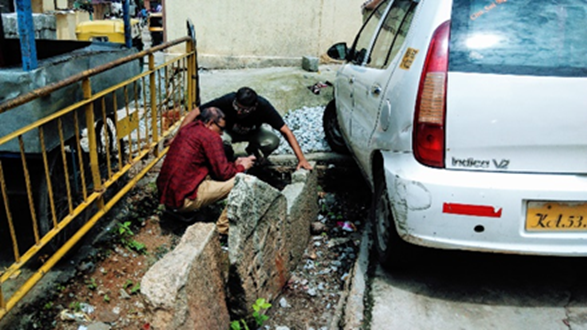
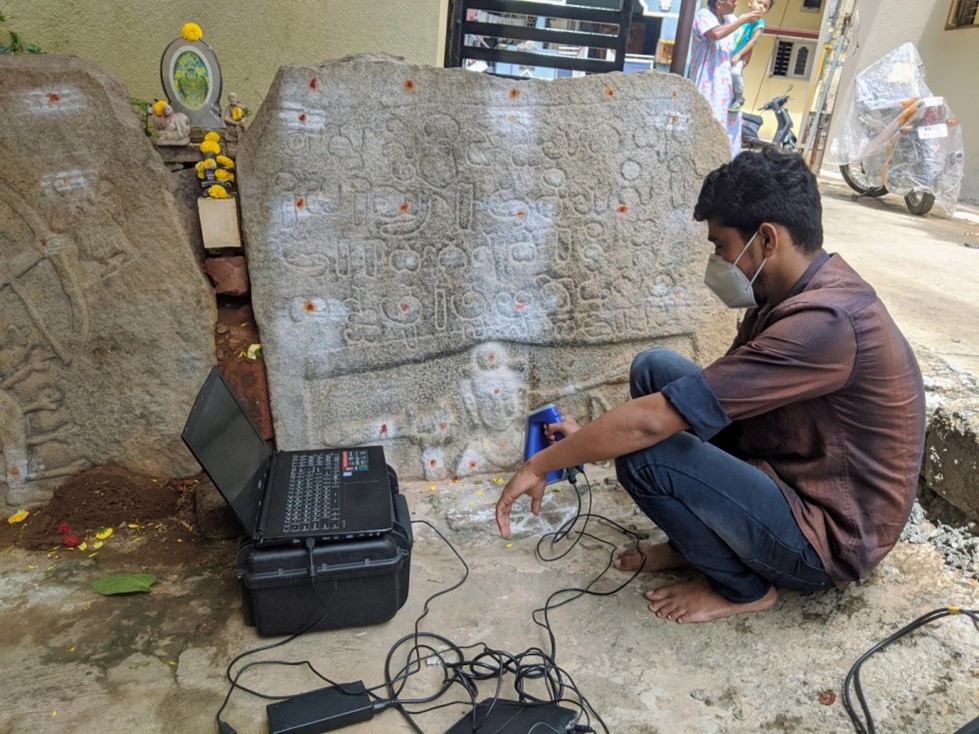
An immediate and tactical solution to conservation is to materially secure an imperilled stone by reinstalling it on a pedestal or by providing protective cover around the inscription. In Bengaluru city so far, some 15 such “vulnerable” inscriptions have been protected by reinstalling them on a pedestal at the same location or relocating them to a nearby park, ground, school, temple, or museum. While this is sufficient in the short term, there is no guarantee that the inscription stone is protected from vandalism or damage due to accidents or carelessness. Despite protection, physical damage can never be ruled out. It has also been observed that even with a good enclosure or other protection, for reasons that are not clear, flaking of stone inscriptions and weathering continues to degrade an inscription. Some possible causes could be increased air pollution, acidic rainwater etc.
Recent technological enhancements enable us to go beyond physical securing of inscriptions. With modern methods we can also “digitally conserve” an inscription stone. A high resolution 3d digital model of an inscription can be developed by 3d digital scanning methods. Based on light (laser or other types of light), the conservation technique is non-contact and safe.
Commercial handheld 3d digital scanners are based on the technique of projecting light from multiple angles and/or patterns onto an object and capturing point reflections from the object in one or multiple cameras. These captured reflections are then used to compute the x,y,z coordinates of points on the object by triangulation algorithms. These points with 3d dimensional coordinates are then used to digitally reconstruct faces and volumes for the object.
A mobile handheld scanner provides the added advantage of in-situ scanning which is a key requirement for scanning stone inscriptions (fig 10)12. Once developed, a 3d model is an accurate representation of the existing condition of the inscription and lasts forever without degradation.
In addition to conservation, a high-resolution 3d digital model helps “democratise” information in extraordinary ways. A “micron” accurate 3d digital model can be shared electronically and such a shared model can be studied by anyone anywhere in the world from the comfort of their homes and offices. It will no longer be necessary for a researcher or anyone interested to visit the site of the inscription to take flour traces or estampages.
A high quality 3d digital model also enables us to produce high quality replicas. Any material could be used for making a replica - wood, stone, metal, plastic are all possible material choices. While a stone inscription on a pedestal is a valuable and a venerated object, a good quality replica can also be valuable in many ways, maybe to help generate funds to maintain the original object itself. Funds for constructing the Hebbal-Kittayya mantapa (fig 7 & 8) in Ganga architectural style were similarly raised from sale of brass mementos of the original inscription Hebbal-Kittayya hero stone. Brass mementos (fig-12) were mass produced from a 3d print of the 3d digital model. Hundreds of such brass mementos are now prized showpieces in homes and offices across the world (fig -12). We even have instances of these mementos being kept in puja rooms and bank lockers!
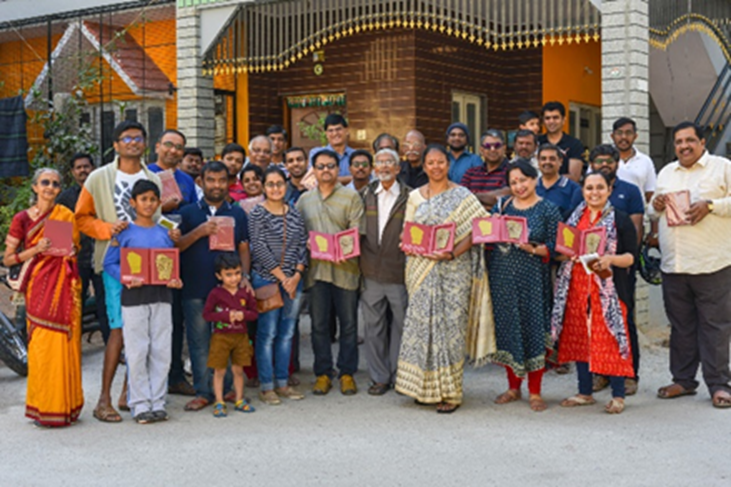
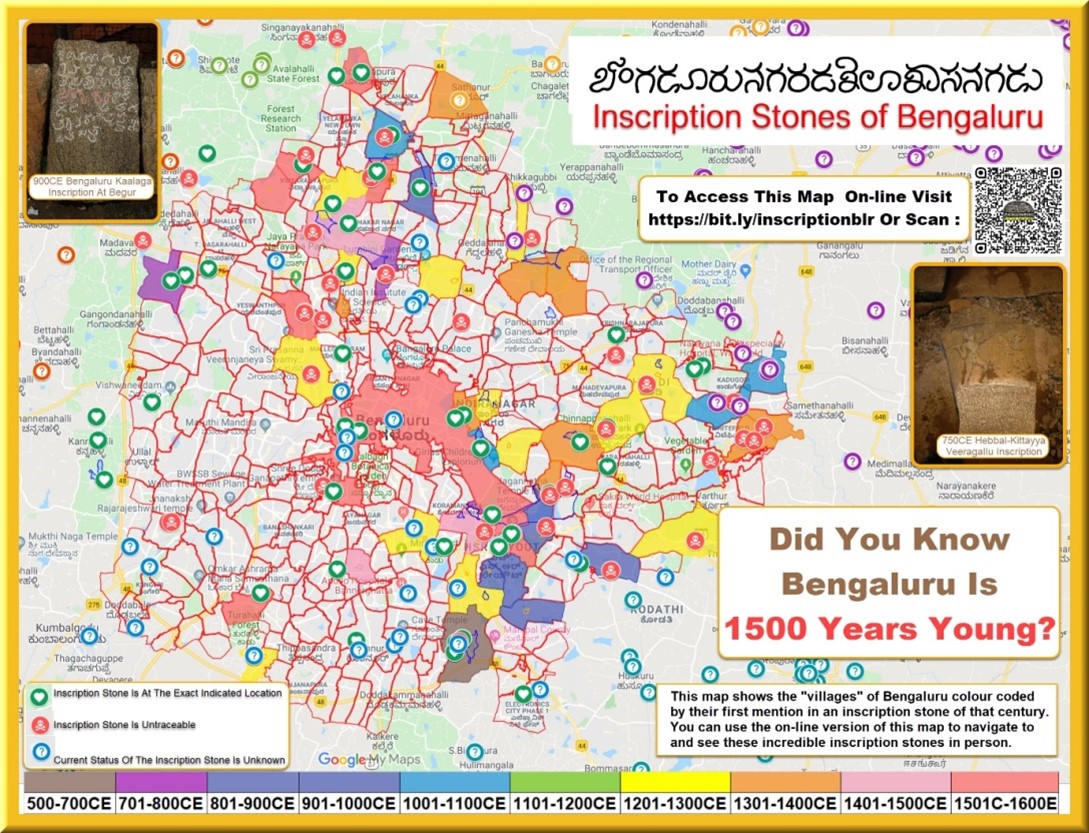
Deciphering the text of an inscription using a 3d digital model and leveraging sophisticated software rendering and lighting algorithms results in significant speed and accuracy improvements over the traditional paper based the deciphering process. The ability to view the 3d digital model of an inscription from any angle, to zoom & pan, change surface colour, change light colours and lighting directions, apply textures, apply digital filters… help bring out the ancient characters in amazing clarity (fig 13). Thus, scope for ambiguous readings is reduced and contentions resolved more easily.
Even deciphering fairly worn out and effaced inscriptions is much easier and faster when working with 3d digital models. We have an excellent example in the case of the 750CE Hebbal-Kittayya inscription deciphered3 by Dr.P.V. Krishnamurthy in 2019. He was able to identify the attackers mentioned in the inscription as from Ratavadi (Rashtrkutas) only after having access to a high-quality digital model of the stone inscription (fig 15).
We have many instances of inscriptions that have been read incorrectly or partially due to human errors and-or because the inscription was worn out. A good quality digital 3d model helps resolve such issues with ease.
Scholarly epigraphists are now a rarity and many inscriptions remain undeciphered due to non-availability of epigraphists to decipher them! A solution to this problem is in the new and evolving area of software applications to automatically decipher inscriptions. High quality 3d digital models are a particularly useful asset for developing Machine Learning (ML) based software applications to automatically read inscriptions.
Inscriptions are legal records accepted by government and civic bodies in administrative matters. In the years to come, with more jostling for space and the resultant increase in civil disputes, this usage of inscriptions in administrative matters is also bound to go up. A well-known, recent example of an inscription being considered in civil dispute adjudication case is the 12th century Vishnu Hari inscription4 by the Supreme Court of India in the 2019 Ayodhya case verdict. The 12th century Vishnu-Hari inscription was evidence considered and discussed at length in the final judgement6.
An example of a Bengaluru stone inscription being submitted as evidence in an ongoing civil dispute is in the matter of Pattandur (located behind ITPL in Whitefield) lake encroachment. A 1043CE inscription7 in Kadugodi is an original record of building of Pattandur Lake. This inscription has now been presented for consideration by the court as evidence to establish the antiquity of the lake. Sadly, this same Pattandur lake inscription currently sits lonely and threatened in a graveyard (fig 14). In the event of physical destruction of an inscription, high quality digital 3d models will be especially useful in such matters.
Bengaluru city is an explosively growing mega city. A city that attracts tens of thousands of global citizens and corporates from every corner of the world. As mentioned before, most residents of the city, whether native or migrant have little knowledge of its incredible millennium years history recorded in stone inscriptions. As a result, the city has already lost much of its valuable heritage in inscriptions. Of the 175 hoary inscriptions in the city, over 100 have already been lost due to this apathy and ignorance. The unceasing march of rapid and chaotic urbanisation now threatens the ~1200 inscriptions in all of Bengaluru district. Therefore, it is extremely essential to 3d digital scan and safeguard these at the earliest. Conscientious citizens have funded 3d scanning of some 25 inscriptions so far (fig 1)8. However, to scan the remaining ~1150, institutional and corporate support is needed. Mythic Society a pioneer in Indic studies has expressed interest to engage in this initiative. Similar interest has also been expressed by a few corporates and citizens.
Our experience with 3d digital scanning of 30 inscriptions indicates that the average scanning and processing time for 3 inscription stones is around 4 days. Therefore, 3d digital scanning of all inscriptions in Bengaluru district is likely to be a 3-4 years project. Considering the threat of destruction to an inscription stone as the main criteria for prioritising scans, an optimal approach will be to first scan all inscriptions in dense urban and semi-urban locations on priority and scan the rest subsequently.
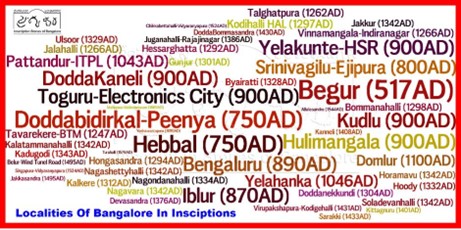
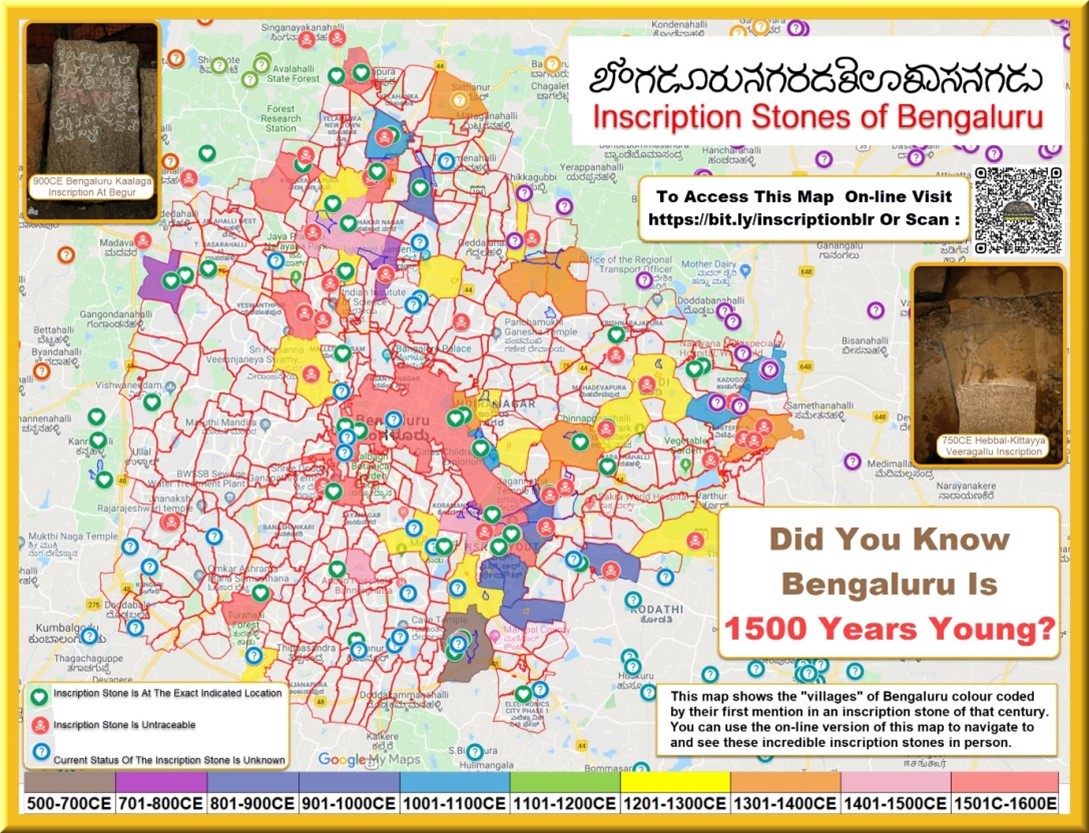
Current state-of-the-art technology allows us to digitally scan, capture and conserve in excellent three-dimensional detail stone inscriptions. Considering the rapid rate at which Bengaluru’s incredible millennium year’s inscription stones heritage is being lost, it is our fervent hope that all Bengaluru’s inscriptions will be digitally scanned quickly and digitally conserved for posterity!
1. E.C. Vol-IX, Bn42 (Nagondanahalli)
2. E.C. Vol-IX, Ht118 (Kitagnur)
3. Itihasa Darpana, Vol 37-38, Apr-Sep 2018 , “Ganga Sripurushana Hebbalada Aprakatita Veeeragallu Shasana Dr. P.V. Krishnamurthy, p 177-182
4. Proceedings of the Indian History Congress (64th session Mysore). Indian History Congress. 64: 348–361), Braj Basi Lal (2003).
5. "The Excavations at Ayodhya". In Robert Layton, Peter G. Stone and Julian Thomas (ed.). Destruction and Conservation of Cultural Property
6. SUPREME COURT OF INDIA, Civil Appeal Nos 10866-10867 of 2010, https://main.sci.gov.in/supremecourt/2010/36350/36350_2010_1_1502_18205_Judgement_09-Nov-2019.pdf
7. E.C. Vol- IX, Ht142 (Patandur)
8. Ithihasa Darshana, 2016, “Bengaluru Poorva Taluku Kaikkondrahalli Aprakatita Nagattarana Shasana” by Adappa Pasodi, p 21-30
9. E.C. Vol-IX, Bn38,39 (Dasarahalli)
10. Aksharameru: Dr P V Krishnamurthy Abhinandana Samputa. Pub 2020, “Benalurina Jakkuru Hagu Naagavarada Aprakita Shasanaglu” by Prof. K.R.Narasimhan, p408-411
